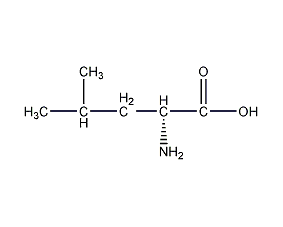D-Leucine


Structural formula
| Business number | 0482 |
|---|---|
| Molecular formula | C6H13NO2 |
| Molecular weight | 131.17 |
| label |
D-Leucine, D-2-amino-4-methylpentanoic acid, D-leucine (D-leucine), D-Leucine, (R)-(-)-LEUCINE, (R)-LEUCINE, (R)-2-AMINO-4-METHYLPENTANOIC ACID, (R)-2-AMINO-4-METHYLVALERIC ACID, d-leucin, Leucine, D-, D-LEU, D-LEUCINE |
Numbering system
CAS number:328-38-1
MDL number:MFCD00063088
EINECS number:206-327-7
RTECS number:OH2840000
BRN number:1721721
PubChem number:24874859
Physical property data
一 , physical property data
Traits :White flaky crystals.
Density (g/mL,25/4℃): Not available
Relative Vapor density (g/mL, air=1):Not available
Melting point (ºC):293
Boiling point (ºC, normal pressure): Not available
Boiling point (ºC, 5.2kPa): Not available
Refraction Rate: Not available
Flash Point (ºC): Not available
Optical rotation (º): 10.34
Spontaneous combustion Point or ignition temperature (ºC): Not available
Steam Pressure (kPa, 25ºC): Not available
saturated Vapor pressure (kPa, 60ºC): Not available
Burn Heat (KJ/mol):Not available
Critical Temperature (ºC): Not available
Critical Pressure (KPa): Not available
oil and water Log value of the (octanol/water) partition coefficient:Not available
Explosion Upper limit (%, V/V): Not available
Explosion Lower limit (%, V/V): Not available
Dissolve Sex: Soluble in water
Toxicological data
Two , Toxicological data:
Acute Toxicity:Mid lethal dose (rat, intraperitoneal)642mg/kg. .
Ecological data
Three , Ecological data:
1 ,Other harmful effects: This substance may be harmful to the environment, and special treatment should be given to water bodies. Notice.
Molecular structure data
1. Molar refractive index: 34.86
2. Molar volume (m3/mol):126.6
3. isotonic specific volume (90.2K):316.4Solubility :Soluble in water
Toxicological data
Two , Toxicological data:
Acute Toxicity:Mid lethal dose (rat, intraperitoneal)642mg/kg. .
Ecological data
Three , Ecological data:
1 ,Other harmful effects: This substance may be harmful to the environment, and special treatment should be given to water bodies. Notice.
Molecular structure data
1. Molar refractive index: 34.86
2. Molar volume (m3/mol):126.6
3. isotonic specific volume (90.2K):316.4
4. Surface Tension (dyne/cm):39.0
5. Polarizability(10-24cm3):13.82
Compute chemical data
1. Reference value for hydrophobic parameter calculation (XlogP): None
2. Number of hydrogen bond donors: 2
3. Number of hydrogen bond acceptors: 3
4. Number of rotatable chemical bonds: 3
5. Number of tautomers: none
6. Topological molecule polar surface area 63.3
7. Number of heavy atoms: 9
8. Surface charge: 0
9. Complexity: 101
10. Number of isotope atoms: 0
11. Determine the number of atomic stereocenters: 1
12. Uncertain number of atomic stereocenters: 0
13. Determine the number of chemical bond stereocenters: 0
14. Number of uncertain chemical bond stereocenters: 0
15. Number of covalent bond units: 1
Properties and stability
None yet
Storage method
Should be sealed and stored dry.
Synthesis method
Use acetyl-DL-leucine as raw material, remove L-leucine through acylase treatment, then hydrolyze with hydrochloric acid to obtain crude product, and obtain pure product after crystallization and purification.
Purpose
For biochemical research.
>
4. Surface Tension (dyne/cm):39.0
5. Polarizability(10-24cm3):13.82
Compute chemical data
1. Reference value for hydrophobic parameter calculation (XlogP): None
2. Number of hydrogen bond donors: 2
3. Number of hydrogen bond acceptors: 3
4. Number of rotatable chemical bonds: 3
5. Number of tautomers: none
6. Topological molecule polar surface area 63.3
7. Number of heavy atoms: 9
8. Surface charge: 0
9. Complexity: 101
10. Number of isotope atoms: 0
11. Determine the number of atomic stereocenters: 1
12. Uncertain number of atomic stereocenters: 0
13. Determine the number of chemical bond stereocenters: 0
14. Number of uncertain chemical bond stereocenters: 0
15. Number of covalent bond units: 1
Properties and stability
None yet
Storage method
Should be sealed and stored dry.
Synthesis method
Use acetyl-DL-leucine as raw material, remove L-leucine through acylase treatment, then hydrolyze with hydrochloric acid to obtain crude product, and obtain pure product after crystallization and purification.
Purpose
For biochemical research.